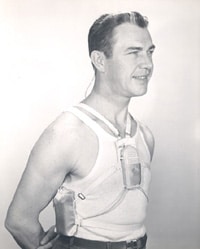So far in this series I’ve discussed Kim, David, and Dr. Judy. Improvements in hearing aid technology and the skill of the audiologist have made it possible for each of these people to continue working despite deteriorating hearing that was pushing them to find another career.
Today I introduce Sam, a machinist, who has very poor hearing. Like Kim, David, and Dr. Judy, Sam was on the verge of changing professions because he was not getting enough help from his hearing aids.
Sam is a real character with a sense of humor. “You’ve heard of people that are stone deaf?” he asked me. “Well, I’m worse than that.”
Sam needs the most powerful hearing aid in the world to hear anything. For him, the more sound the better. He has a box full of old hearing aids: ITEs, BTEs, power-CROS. He even has a couple of old body hearing aids that he loves (Bosh MP80SPs). “They work,” he says. “I get enough sound.”
For years, he wore a body hearing aid with an extra long cord. He addressed the feedback issue by putting the earmold in the right ear and wearing the body aid on his belt on his left side. He needed to have extra-long cords made to do this. The increased microphone-to-receiver distance reduced feedback.
If you’ve worked in this field for many years, you know that ultra-high power hearing aids have been around forever. The problem with them has always been the incessant feedback that they produce. It was feedback that was driving Sam’s wife crazy, and also his fellow employees. Feedback was turning Sam, a very sociable person by nature, into a recluse.
“I stopped going to church,” he told me. “I was embarrassed when people kept complaining that my hearing aid was whistling.”
Technology to the Rescue
Several recent breakthroughs in hearing aid technology have helped Sam and people like him to hear without generating loud feedback:
- Feedback-control software allows us to study a fitting and see the exact zone where feedback is occurring.
- Multi-band amplification makes it possible for us to reduce amplification in very narrow frequency bands, but without reducing the overall amplification too much.
- Modern real-time, feedback-cancellation software is very effective.
- The development of better earmolds and better ear impression materials has also helped us overcome feedback.
Sam’s fitting has no feedback in the lower frequencies, so I give him a huge amount of output in that region. I set the output in the higher frequencies just below the observed feedback line.
An on-board, feedback-suppression system captures and studies the feedback, inverts the phase, and cancels it.
Feedback is one of those “monsters” that we are coming closer to exterminating every year. Today’s hearing aids are engineered to eliminate a greater and greater amount of feedback.
Earmold Strategies
The experts at the earmold labs have lots of tricks they use to eliminate feedback, such as making the earmold extra thick with a slight “rim” (like a bullet) on the outer edge. With help from these experts, I am continually making new earmolds for patients who need extra power.
I made three sets of earmolds for Sam: one designed for comfort, one for maximum hearing and feedback reduction, and one experimental set. Making earmolds is an art form, more than a science, and when you make earmolds for difficult cases like Sam’s, you improve your chances of success by trying different ideas and talking to your expert at the factory. Ordering an experimental set lets me try things such as making the earmold extra long, increasing the tightness at the aperture to the ear canal, putting a special coating on the plastic, etc., etc.
Mega-power fittings like Sam’s are highly problematic, and in doing them there is no substitute for the skill derived from years of clinical practice. High-output fittings require dedication, persistence, and a little bit of luck. Miracles are possible, but they don’t come easy.
In Sam’s case, the increase in feedback-free amplification allows him to hear. Now Sam is happy–and so is his wife.
Author’s note: I have been in this business for many years. Every time I needed technical help with a high-power fitting, I used to call Pat Vanderpool, a long-time customer support audiologist who worked for two major hearing aid manufacturers in the U.S. I cannot tell you how much help I received from Pat and how much I learned from her. The woman was brilliant. Sadly, we lost her recently. We miss you, Pat. Thank you.
feature image courtesy of Becker Exhibits







